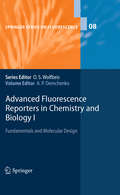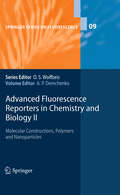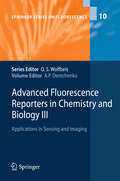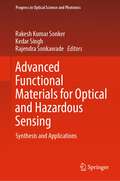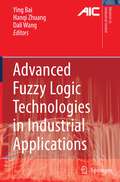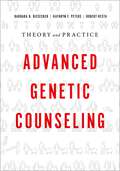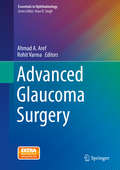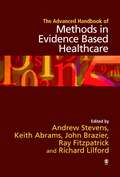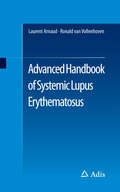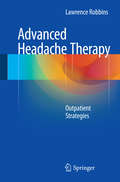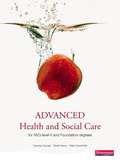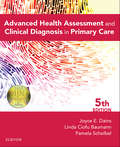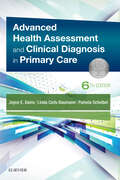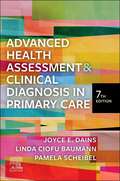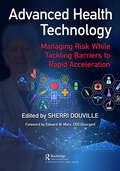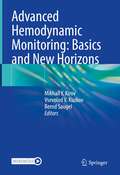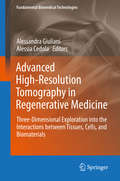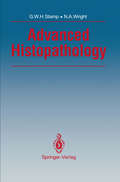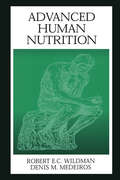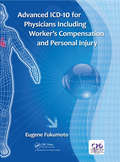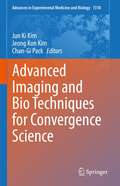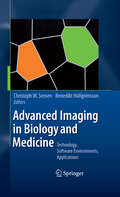- Table View
- List View
Advanced Fluorescence Reporters in Chemistry and Biology I: Fundamentals and Molecular Design (Springer Series on Fluorescence #8)
by Alexander P. DemchenkoFluorescence reporter is the key element of any sensing or imaging technology. Its optimal choice and implementation is very important for increasing the sensitivity, precision, multiplexing power, and also the spectral, temporal, and spatial reso- tion in different methods of research and practical analysis. Therefore, design of ?uorescence reporters with advanced properties is one of the most important problems. In this volume, top experts in this ?eld provide advanced knowledge on the design and properties of ?uorescent dyes. Organic dyes were the ?rst ?uorescent materials used for analytical purposes, and we observe that they retain their leading positions against strong competition of new materials – conjugated polymers, semiconductor nanocrystals, and metal chelating complexes. Recently, molecular and cellular biology got a valuable tool of organic ?uorophores synt- sized by cell machinery and incorporated into green ?uorescent protein and its analogs. Demands of various ?uorescence techniques operating in spectral, anisotropy, and time domains require focused design of ?uorescence reporters well adapted to these techniques. Near-IR spectral range becomes more and more attractive for various applications, and new dyes emitting in this range are strongly requested. Two-photonic ?uorescence has become one of the major tools in bioimaging, and ?uorescence reporters well adapted to this technique are in urgent need. These problems cannot be solved without the knowledge of fundamental principles of dye design and of physical phenomena behind their ?uorescence response.
Advanced Fluorescence Reporters in Chemistry and Biology II: Molecular Constructions, Polymers and Nanoparticles (Springer Series on Fluorescence #9)
by Alexander P. DemchenkoWith contributions by numerous experts
Advanced Fluorescence Reporters in Chemistry and Biology III: Applications in Sensing and Imaging (Springer Series on Fluorescence #10)
by Alexander P. DemchenkoThe key element of any fluorescence sensing or imaging technology is the fluorescence reporter, which transforms the information on molecular interactions and dynamics into measurable signals of fluorescence emission. This book, written by a team of frontline researchers, demonstrates the broad field of applications of fluorescence reporters, starting from nanoscopic properties of materials, such as self-assembled thin films, polymers and ionic liquids, through biological macromolecules and further to living cell, tissue and body imaging. Basic information on obtaining and interpreting experimental data is presented and recent progress in these practically important areas is highlighted. The book is addressed to a broad interdisciplinary audience.
Advanced Functional Materials for Optical and Hazardous Sensing: Synthesis and Applications (Progress in Optical Science and Photonics #27)
by Rakesh Kumar Sonker Kedar Singh Rajendra SonkawadeThis book highlights the significance and usefulness of nanomaterials for the development of sensing devices and their real-life applications. The book also addresses various means of synthesizing functional materials, e.g., hydrothermal deposition process, electrospinning, Ostwald ripening, sputtering heterogeneous deposition, liquid-phase preparation, the vapor deposition approach, and aerosol flame synthesis. It presents an informative overview of the role of functional materials in the development of advanced sensor devices at the nanoscale and discusses the applications of functional materials in different forms prepared by diverse techniques in the field of optoelectronics and biomedical devices. Major features, such as type of advanced functional, fabrication methods, applications, tasks, benefits and restrictions, and saleable features, are presented in this book. Advanced functional materials for sensing have much wider applications and have an enormous impact on our environment.
Advanced Fuzzy Logic Technologies in Industrial Applications (Advances in Industrial Control)
by Ying Bai Hanqi Zhuang Dali WangThis book introduces a dynamic, on-line fuzzy inference system. In this system membership functions and control rules are not determined until the system is applied and each output of its lookup table is calculated based on current inputs. The book describes the real-world uses of new fuzzy techniques to simplify readers’ tuning processes and enhance the performance of their control systems. It further contains application examples.
Advanced Genetic Counseling: Theory and Practice
by Barbara B. Biesecker Kathryn F. Peters Robert RestaA CRITICAL NEW APPROACH FOR LEARNING AND THRIVING IN A FIELD OF CHANGE The scope and responsibilities of today's genetic counselors exceed the reasonable capacity of any one educational resource. While the field's first-year curriculum may be relatively fixed, the landscape of what comes after that -- a dizzying mix of practice, ethics, research design, and professional competencies -- is increasingly broad. Advanced Genetic Counseling offers an overdue extension of the field's core curriculum. From navigating ethical dilemmas and potential conflicts of interest to confronting the biases and patterns of thought that can limit counselors' interactions with clients, it prepares readers to face the profession's most challenging aspects with confidence. Drawing on techniques from psychotherapy, social psychology, and health behavior, Advanced Genetic Counseling is an essential resource for trainees and mid-career professionals. It offers a roadmap not just for addressing client needs, but for the future of genetic counseling education.
Advanced Genetic Counseling: Theory and Practice
by Barbara B. Biesecker Kathryn F. Peters Robert RestaA CRITICAL NEW APPROACH FOR LEARNING AND THRIVING IN A FIELD OF CHANGE The scope and responsibilities of today's genetic counselors exceed the reasonable capacity of any one educational resource. While the field's first-year curriculum may be relatively fixed, the landscape of what comes after that -- a dizzying mix of practice, ethics, research design, and professional competencies -- is increasingly broad. Advanced Genetic Counseling offers an overdue extension of the field's core curriculum. From navigating ethical dilemmas and potential conflicts of interest to confronting the biases and patterns of thought that can limit counselors' interactions with clients, it prepares readers to face the profession's most challenging aspects with confidence. Drawing on techniques from psychotherapy, social psychology, and health behavior, Advanced Genetic Counseling is an essential resource for trainees and mid-career professionals. It offers a roadmap not just for addressing client needs, but for the future of genetic counseling education.
Advanced Glaucoma Surgery (Essentials in Ophthalmology)
by Ahmad A. Aref Rohit VarmaThis text provides expert instruction on the techniques currently employed for the surgical treatment of glaucomatous disease, covering both the host of novel microinvasive devices for treatment of milder stages and the refined strategies that enhance success rates in patients with advanced disease. The critical steps in each procedure are clearly described with the aid of many high-quality illustrations and surgical videos. Pearls and pitfalls of the various techniques are highlighted, and helpful information is provided on indications, preoperative considerations, potential intra- and postoperative complications, and strategies for reducing the incidence of such adverse events. Each treatment method is addressed in a dedicated stand-alone chapter, ensuring ease of reference for the practitioner. Readers will find this book, written by internationally recognized experts in the field, to be an exceptional source of up-to-date information on advanced glaucoma surgical techniques.
The Advanced Handbook of Methods in Evidence Based Healthcare (PDF)
by Mr John Brazier Mr Ray Fitzpatrick Professor Andrew J Stevens Professor Keith R Abrams Richard J Lilford'This handbook is an excellent reflection of the growing maturity and methodological sophistication of the field of Health Technology Assessment. The Handbook covers a spectrum of issues, from primary evidence (clinical trials) through reviews and meta-analysis, to identifying and filling gaps in the evidence. Up-to-date, clearly written, and well-edited, the handbook is a needed addition to any personal or professional library dealing with Health Technology Assessment.' Professor David Banta, TNO Prevention and Health, The Netherlands 'This text presents the most advanced knowledge on methodology in health care research, and will form the backbone of many future studies' - Paula Roberts, Nurse Researcher The `effectiveness revolution' both in research and clinical practice, has tested available methods for health services research to the extreme. How far can observational methods, routine data and qualitative methods be used in health care evaluation? What cost and outcome measures are appropriate, and how should data be gathered? With the support of over two million pounds from the British Health Technology Assessment Research Programme, the research project for this Handbook has led to both a synthesis of all of the existing knowledge in these areas and an agenda for future debate and research. The chapters and their authors have been selected through a careful process of peer review and provide a coherent and complete approach to the field. The handbook has been a unique collaboration between internationally regarded clinicians, statisticians, epidemiologists, social scientists, health economists and ethicists. It provides the most advanced thinking and the most authoritative resource for a state of the art review of methods of evaluating health care and will be required reading for anyone involved in health services research and management.
Advanced Handbook of Systemic Lupus Erythematosus
by Laurent Arnaud Ronald Van VollenhovenThis book will provide an introduction to the epidemiology, etiology and pathogenesis of the condition while also exploring the classification, diagnosis, and current and emerging therapies for systemic lupus erythematosus. Systemic lupus erythematosus is an autoimmune disease in which the body's immune system mistakenly attacks healthy tissue. It can affect the skin, joints, kidneys, brain, and other organs. The underlying cause of the disease is not fully known, and SLE is much more common in women than in men. It may occur at any age but most often occurs in people between 10 and 50 years of age. This is the second Adis title from Ronald F van Vollenhoven, who previously authored Biologics for the Treatment of Rheumatoid Arthritis.
Advanced Headache Therapy: Outpatient Strategies
by Lawrence RobbinsThis cutting-edge book will cover various aspects of headache management, with a focus on difficult patients. Practical, step-by-step advice for treating challenging headaches, including migraine, refractory and cluster headaches, will be provided in detail along with how to approach patients of different ages and those with psychological disorders. Unique and complex case studies and complete explanations to the vast array of medications will also be featured. Authored by one of the leading experts on refractory headaches, Advanced Headache Management will be an invaluable guide for the resident or clinician and an easy-to-read resource for many patients.
Advanced Health and Social Care For NVQ and Foundation Degrees
by Frances Sussex Peter Scourfield David HerneThis title delivers the most effective learning resource possible by incorporating customer feedback to build on the strength of the original book. It is written in the same accessible language as the first edition and designed for quick and easy reference. It features a new chapter on study skills, helping students to maximise their study time. It includes more on quality management and promoting health and well-being, so students can be sure that the areas they need are covered in depth.
Advanced Health Assessment & Clinical Diagnosis in Primary Care - E-Book
by Joyce E. Dains Linda Ciofu Baumann Pamela ScheibelTake the ‘next step’ in health assessment! Advanced Health Assessment and Clinical Diagnosis in Primary Care, 5th Edition goes beyond basic history and physical examination to help you master the diagnostic reasoning process. You’ll develop this key skill by following assessment guidelines that focus on a specific complaint rather than beginning with a previously established diagnosis or disease entity. Written by advanced practice nursing experts Joyce Dains, Linda Baumann, and Pamela Scheibel, this edition includes new chapters on evidence-based preventive health screening and on heartburn and indigestion, along with a new full-color design. Master the differential diagnosis process outlined in this book, and you’ll be able to accurately diagnose the majority of patients seen in today’s primary care settings.A clear, consistent diagnostic reasoning process takes you to the next step of health assessment — beyond basic history and physical examination to diagnostic reasoning.Diagnostic Reasoning: Focused History sections use ‘self-questions’ to walk you through the thinking process involved in obtaining a pertinent, relevant, problem-specific history that will assist in differential diagnosis.Diagnostic Reasoning: Focused Physical Examination sections explain how to perform more advanced diagnostic techniques and interpret the findings.Key Questions guide you through assessment and toward an accurate diagnosis by listing questions to ask the patient, followed by explanations of what the patient's responses might signify.Laboratory and Diagnostic Studies sections outline the types of studies that might be appropriate based on the focused history and focused physical examination.Differential Diagnosis sections offer the most common diagnoses for each patient problem and summarize the history and physical examination findings, along with recommended laboratory and diagnostic studies.Differential Diagnosis tables provide a quick-reference summary of possible diagnoses for each patient problem.Evidence-Based Practice boxes — more than 30 are NEW — summarize the scientific evidence related to the diagnosis of patient problems.Alphabetical Table of Contents provides a convenient listing of common health problems.
Advanced Health Assessment & Clinical Diagnosis in Primary Care E-Book
by Joyce E. Dains Linda Ciofu Baumann Pamela ScheibelLearn to accurately diagnose the majority of patients seen in today’s primary care settings! Advanced Health Assessment and Clinical Diagnosis in Primary Care, 6th Edition goes beyond basic history and physical examination skills to help you learn the diagnostic reasoning process. You will develop this key skill by following assessment guidelines that focus on a specific complaint rather than beginning with a previously established diagnosis or disease entity. Written by advanced practitioners, this edition includes a new chapter on The Transgender Patient that gives you the knowledge you need to properly assess and care for this underserved patient population. It also features expanded coverage of geriatrics, highly infectious diseases, coordination with the interprofessional healthcare team, genetics/genomics in lab testing and family history, updates on psychiatric-mental health problems, and more!A clear, consistent diagnostic reasoning process takes you to the next step of health assessment -- beyond basic history and physical examination to diagnostic reasoning.Diagnostic Reasoning: Focused History sections use "self-questions" to walk you through the thinking process involved in obtaining a pertinent, relevant, problem-specific history that will assist in differential diagnosis.Diagnostic Reasoning: Focused Physical Examination sections explain how to perform more advanced diagnostic techniques and interpret the findings.Key Questions guide you through assessment and toward an accurate diagnosis by listing questions to ask the patient, followed by explanations of what the patient's responses might signify.Laboratory and Diagnostic Studies sections outline the types of tests that might be appropriate based on the focused history and focused physical examination.Differential Diagnosis sections offer the most common diagnoses for each patient problem and summarize the history and physical examination findings, along with recommended laboratory and diagnostic studies.Differential Diagnosis tables provide you with a quick-reference summary of possible diagnoses for each patient problem.Evidence-Based Practice boxes -- more than 30 NEW -- summarize the scientific evidence related to the diagnosis of patient problems.Evidence-Based Preventive Health Screening chapter helps you to screen for common asymptomatic conditions and promote wellness.Information on screening for abuse and sexual assault helps you identify patients who might need additional support or intervention.List of Chapters by Body System provides a convenient Table of Contents organized by body system.
Advanced Health Assessment & Clinical Diagnosis in Primary Care - E-Book
by Joyce E. Dains Linda Ciofu Baumann Pamela ScheibelTake the next step in health assessment by building your skills in diagnostic and clinical reasoning! Advanced Health Assessment and Clinical Diagnosis in Primary Care, 7th Edition goes beyond the basic physical examination to help you learn to accurately evaluate common conditions. Organized by patient symptoms or complaints, the book follows a systematic approach beginning with a chief concern rather than a specific diagnosis or disease entity, then guides you step-by-step through a diagnostic reasoning process to lead to a clinical diagnosis. This edition includes new chapters on veterans’ health and on contemporary approaches in primary care settings, as well as updated content on issues such as race, ethnicity, and gender identity. Written by a team of advanced practitioners led by Joyce E. Dains, this AJN award-winning text helps you learn to think like an expert clinician.
Advanced Health Technology: Managing Risk While Tackling Barriers to Rapid Acceleration
by Sherri DouvilleEverything worth winning in life boils down to teamwork and leadership. In my positions as a businessman, athlete, community leader, and University trustee, there are tremendous parallels between all of these endeavors that mirror an extreme team sport such as medical technology. Understanding the game, defining the game, playing your position at your highest performance, and helping others play their best game. Advanced Health Technology represents an incredible opportunity to level up the game of healthcare and highlights the multiple disciplines – or positions to be mastered – while laying out winning plays to make that next level happen. Ronnie Lott, Managing Member, Lott Investments; Member, Pro Football Hall of Fame, and Trustee, Santa Clara University Healthcare stakeholders are paralyzed from making progress as risks explode in volume and complexity. This book will help readers understand how to manage and transcend risks to drive the quadruple aim of improved patient experiences, better patient and business outcomes, improved clinician experience, and lower healthcare costs, and also help readers learn from working successful examples across projects, programs, and careers to get ahead of these multidisciplinary healthcare risks.
Advanced Health Technology: Managing Risk While Tackling Barriers to Rapid Acceleration
by Sherri DouvilleEverything worth winning in life boils down to teamwork and leadership. In my positions as a businessman, athlete, community leader, and University trustee, there are tremendous parallels between all of these endeavors that mirror an extreme team sport such as medical technology. Understanding the game, defining the game, playing your position at your highest performance, and helping others play their best game. Advanced Health Technology represents an incredible opportunity to level up the game of healthcare and highlights the multiple disciplines – or positions to be mastered – while laying out winning plays to make that next level happen. Ronnie Lott, Managing Member, Lott Investments; Member, Pro Football Hall of Fame, and Trustee, Santa Clara University Healthcare stakeholders are paralyzed from making progress as risks explode in volume and complexity. This book will help readers understand how to manage and transcend risks to drive the quadruple aim of improved patient experiences, better patient and business outcomes, improved clinician experience, and lower healthcare costs, and also help readers learn from working successful examples across projects, programs, and careers to get ahead of these multidisciplinary healthcare risks.
Advanced Hemodynamic Monitoring: Basics and New Horizons
by Mikhail Y. Kirov Vsevolod V. Kuzkov Bernd SaugelThis book describes how to monitor and optimize cardiovascular dynamics using advanced hemodynamic monitoring in perioperative and intensive care medicine. The book outlines basic skills of hemodynamic monitoring, different techniques including invasive, minimally invasive, and non-invasive methods, and algorithms and treatment strategies for perioperative goal-directed hemodynamic therapy in different groups of surgical patients. Thus, the book reflects current diagnostic and therapeutic approaches in perioperative and intensive care medicine. All sections of this book have a learning-oriented style and are illustrated with tables and figures summarizing the main content. The volume is addressed both to specialists and residents using advanced hemodynamic monitoring; it reflects indications and limitations of current monitoring tools and discuss therapeutic strategies. It also helps readers to integrate new knowledge on monitoring of cardiovascular dynamics into clinical practice.
Advanced High-Resolution Tomography in Regenerative Medicine: Three-dimensional Exploration Into The Interactions Between Tissues, Cells, And Biomaterials (Fundamental Biomedical Technologies)
by Alessandra Giuliani Alessia CedolaThis book covers the state-of-the-art research on advanced high-resolution tomography, exploring its role in regenerative medicine. and also explores the 3D interactions between tissues, cells, and biomaterials. Various multidisciplinary paths in regenerative medicine are covered, including X-ray microtomography and its role in regenerative medicine, synchrotron radiation-based microtomography and phase contrast tomography, the challenge of the vascularization of regenerated tissues, lung and cartilage imaging, and more. This is an ideal book for biomedical engineers, biologists, physicists, clinicians, and students who want to pursue their studies in the field of regenerative medicine.This book also:Reviews in detail the algorithms and software used for the 3D exploration of regenerated tissueCovers the latest research on the use of X-ray microtomography for muscle diseasesDetails applications of synchrotron radiation tomography in orthopedics and dentistry
Advanced Histopathology
by Gordon W.H. Stamp N.A. WrightIt is easy to be confident that an appropriate body of advice is available to candidates about the content of an examination once you have passed it. Prospectively, the Primary and Final Examinations of the Royal College of Pathologists will appear to most to involve the assimilation of what seems at the time an inexhaustible volume of data, and the recent change in the College examination system has not diminished this concern for the majority of candidates. The guidelines for training for the new Part I examination state that this is the "major hurdle of the MRCPath" and it is clear that it will determine whether candidates are suitable for training which will permit them to practise independently as consultants after Part II. These general aims and objectives do not answer questions such as "How much do I need to know about glomerulonephritis?" or "Where do I stop with the lymphomas?" This text attempts to resolve the difficulty of knowing what standard to aim at, using College questions as its starting point. It concentrates on the essential basis of any single answer; many candidates for the new three-year examination will know more about individual topics than is stated here. However, it is the breadth of information required which is a feature of College examinations and this text should help with this problem.
Advanced Human Nutrition
by Robert E.C. Wildman Denis M. MedeirosThis text begins with an in-depth overview into the human organism at the molecular, cellular, tissue and organ levels, and develops into a discussion of the objectives and features of organ systems of the evolved human. The book also covers the relationship between the human body and the environment in which it exists including other organisms tha
Advanced ICD-10 for Physicians Including Worker’s Compensation and Personal Injury
by Eugene FukumotoICD-10 is the 10th revision of the International Statistical Classification of Diseases and Related Health Problems (ICD), a medical classification list by the World Health Organization. It contains codes for diseases, signs and symptoms, abnormal findings, complaints, social circumstances, and external causes of injury of diseases. The code set allows more than 14,000 different codes and permits the tracking of many new diagnoses. The U.S. has used ICD-10-CM (Clinical Modification) since October, 2015. This national variant of ICD-10 was provided by the Centers for Medicare and Medicaid Services (CMS) and the National Center for Health Statistics, and the use of ICD-10-CM codes are now mandated for all inpatient medical reporting requirements. This book is for physicians, practice managers and all others who need learn ICD-10. It’s designed for the clinician to learn how to put their diagnosis into a code and not rely on staff or computer software programs to decide it form them. ICD-10 is a complex system of coding and Medicare and third party insurers have been lenient giving providers a year to get used to the coding system. As a result, physicians and their staff have become very complacent regarding proper coding. However, Medicare and third party insurers will soon begin to deny claims which are not coded correctly, which in turn will cost physician groups time and money. This book focuses on Worker’s Compensation and Personal Injury, a very large segment of the healthcare industry and is a new area to ICD-10. The diagnosis coding for injuries is much different than for Medicare or group insurance and unless the physicians and their staff learn how to use it properly, they risk losing income for themselves and worse, they risk losing the case for the patient.
Advanced ICD-10 for Physicians Including Worker’s Compensation and Personal Injury
by Eugene FukumotoICD-10 is the 10th revision of the International Statistical Classification of Diseases and Related Health Problems (ICD), a medical classification list by the World Health Organization. It contains codes for diseases, signs and symptoms, abnormal findings, complaints, social circumstances, and external causes of injury of diseases. The code set allows more than 14,000 different codes and permits the tracking of many new diagnoses. The U.S. has used ICD-10-CM (Clinical Modification) since October, 2015. This national variant of ICD-10 was provided by the Centers for Medicare and Medicaid Services (CMS) and the National Center for Health Statistics, and the use of ICD-10-CM codes are now mandated for all inpatient medical reporting requirements. This book is for physicians, practice managers and all others who need learn ICD-10. It’s designed for the clinician to learn how to put their diagnosis into a code and not rely on staff or computer software programs to decide it form them. ICD-10 is a complex system of coding and Medicare and third party insurers have been lenient giving providers a year to get used to the coding system. As a result, physicians and their staff have become very complacent regarding proper coding. However, Medicare and third party insurers will soon begin to deny claims which are not coded correctly, which in turn will cost physician groups time and money. This book focuses on Worker’s Compensation and Personal Injury, a very large segment of the healthcare industry and is a new area to ICD-10. The diagnosis coding for injuries is much different than for Medicare or group insurance and unless the physicians and their staff learn how to use it properly, they risk losing income for themselves and worse, they risk losing the case for the patient.
Advanced Imaging and Bio Techniques for Convergence Science (Advances in Experimental Medicine and Biology #1310)
by Jun Ki Kim Jeong Kon Kim Chan-Gi PackThis book is a wide-ranging guide to advanced imaging techniques and related methods with important applications in translational research or convergence science as progress is made toward a new era in integrative healthcare. Conventional and advanced microscopic imaging techniques, including both non-fluorescent (i.e., label-free) and fluorescent methods, have to date provided researchers with specific and quantitative information about molecules, cells, and tissues. Now, however, the different imaging techniques can be correlated with each other and multimodal methods developed to simultaneously obtain diverse and complementary information. In addition, the latest advanced imaging techniques can be integrated with non-imaging techniques such as mass spectroscopic methods, genome editing, organic/inorganic probe synthesis, nanomedicine, and drug discovery. The book will be of high value for researchers in the biological and biomedical sciences or convergence science who need to use these multidisciplinary and integrated techniques or are involved in developing new analytical methods focused on convergence science.
Advanced Imaging in Biology and Medicine: Technology, Software Environments, Applications
by Ch. W. Sensen Benedikt HallgrimssonA picture says more than a thousand words. This is something that we all know to be true. Imaging has been important since the early days of medicine and bi- ogy, as seen in the anatomical studies of Leonardo Da Vinci or Andreas Vesalius. More than 100 years ago, the ?rst noninvasive imaging technologies, such as K- rad Roentgen’s X-ray technology,were applied to the medical ?eld—and while still crude—revolutionized medical diagnosis. Today, every patient will be exposed to some kind of advanced imaging technology such as medical resonance imaging, computed tomography or four-dimensional ultrasound during their lifetime. Many diseases, such as brain tumors, are initially diagnosed solely by imaging, and most of the surgical planning relies on the patient imagery. 4D ultrasound is available to expecting parents who wish to create unique early memories of the new baby, and it may soon be used for the morphometric diagnosis of malformations that may one day be treatable—inutero! Light and electron microscopy are unequal brethren, which have contributed to most of our knowledge about the existence and organization of cells, tissues and microorganisms. Every student of biology or medicine is introduced to the fascinating images of the microcosm. New advances have converted these im- ing technologies, which were considered by many to be antiquated, into powerful tools for research in systems biology and related ?elds.
